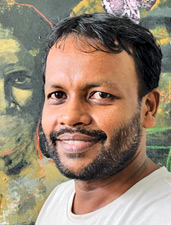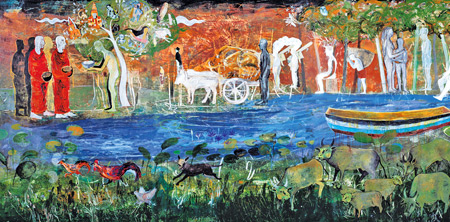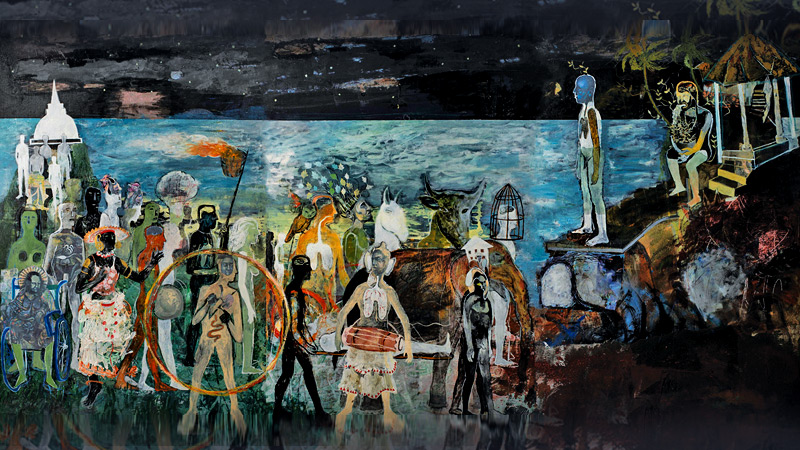
Chamila Gamage
We are made up of memories. Some we remember, some we do not, some emerge fleetingly, some stay with us affecting our core being. Memories of childhood form adulthood.
According to Khalil Gibran, “‘Yesterday is but today’s memory and tomorrow is today’s dream.” Though ancient wisdom has revealed that if we are to find liberation. Even momentarily, we need to be in the present, the pendulum-like human mind inclines to shift swiftly from the past to the future.
This is what struck me when I saw the paintings of Chamila Gamage’s current exhibition ‘Memory Wall’.
 It was a mystical culmination of memories and dreams which seemed to flow across the walls of the Barefoot Gallery. It was something here and now but at the same time not. It held the viewers gaze demanding probe, instigating strange thought processes and emotions, creating stories in the minds of the audience. It deserved attention, analysis and therefore I was compelled to speak to the creator of the art works.
It was a mystical culmination of memories and dreams which seemed to flow across the walls of the Barefoot Gallery. It was something here and now but at the same time not. It held the viewers gaze demanding probe, instigating strange thought processes and emotions, creating stories in the minds of the audience. It deserved attention, analysis and therefore I was compelled to speak to the creator of the art works.
When asked what inspired him to create this series which has some similarities with his earlier work but undoubtedly is quite different conceptually, Chamila Gamage replied.
“About four years ago I met the veteran Swiss filmmaker Andre Martin. He visits Sri Lanka frequently and had somehow seen my art. He was very interested and we ended up having a long discussion about cinema and visual art. His aesthetic sense and cinematic sensibilities were very intriguing, He was planning to write a fictitious account based on the 2004 Tsunami and the way he approached the subject matter fascinated me. Instead of overly dramatized, ‘in your face’ kind of story telling, he opted for subtle, nuanced, paradoxical revelation. He believed in focusing on beauty amidst ugliness and ugliness amidst beauty. That conversation immediately led me to conceptualize a new series of paintings”

Tsunami II
Then onwards Chamila had taken a few significant actual occurrences or contexts and instead of depicting reality he had begun to convey in a somewhat fictitious, surrealistic manner using symbolism. Most of the paintings ended up like dreams with an element of fantasy. Andre Martin’s conversation had reminded Chamila of the Sinhala poetic work ‘Ayyanayake Kavi’ which he had studied in school and especially the line ‘Balayak nathath mehi balayak thibenu pene’. (Though there may be no power in this, a certain power could be sensed.)
This mystical, mythological aesthetic sense had influenced Chamila’s initial sketches and the painting process thereafter had been a slow, four year long one. Although the initial paintings were based on his own experiences of the destruction caused by the 30 year long civil war, 2004 Tsunami and experiences of rural village life, the recent economic crisis and socio-political chaos had impacted some of the paintings.
Tsunami
I inquired about two very significant paintings which were based on the Tsunami. “I wasn’t interested in relating the usual narrative. Yes, I acknowledge that the Tsunami caused a great deal of pain and agony but I wanted to bring about a sense of peace along with grief which comes with death. I used three layers in one painting: a fish which indicates underwater phenomena which isn’t visible to us, a floating woman who seems to be at peace which indicates death, and the visible calamity and chaos caused by the Tsunami. I was also very intrigued by something Andre said.

Imagined village (Nostalgic)
He asked me how we could demand justice from nature after a natural disaster.” We cannot take nature to a court of law. This made me come up with the concept where the dead and the living were going in a procession to the beach to demand justice from the ocean,” Chamila elaborated.
Chamila believes that art is a tool to address and reveal the psyche. While most would be reluctant to delve into their own psychological worlds, Chamila dives in without fear to investigate the hidden: the darkness or the light within. He says his fascination and liaison with world cinema has influenced his art tremendously.
At the same time he acknowledges the influence of somewhat surrealistic, fantastical writings of Simon Nawagaththegama and cinematic work of Boodi Keerthisena and Jayanatha Chandrasiri. “As an art director at Rupavahini I had the opportunity to work with talented directors such as Santhusha Liynage. Collaborating with his 40 episode interpretation of ‘Le Miserable’ was crucial for my conceptual growth. The use of semiotics to portray intense human emotions and intricacies of humaneness was an unforgettable experience which somewhat influenced the series of paintings for ‘Memory Wall’. I used this learning to convey hidden nuances and not the evident tragedy of natural disasters or war.”

Memories of Dreams (I)
Another intriguing work was that of village life in Sri Lanka. Although the common sights which convey beauty and serenity had been used, Chamila had also attempted to show the complexities and hardships of rural living. The painting indicates issues of caste disparity, colonialism, and all these intangible undercurrents are surfaced with the usage of symbols.
One of the most emotionally driven paintings of this series is that of the white elephant who carries a pack of caged rabid dogs. One could easily sense the rage and the pain the artist is trying to convey. When probed about this painting Chamila says that it is the aftermath of the economic crisis and the social uprising ‘Aragalaya’ which prompted him to paint it.
“The Aragalaya initially was an organic, authentic attempt by the population to rise against the hardship caused by malpractice, corruption and mismanagement. However it was soon evident how certain funded groups and individuals took control and used ‘Aragalaya’ to fulfill their own agendas. It is the distaste that I felt towards this occurrence that I am trying to convey.
The white elephant indicates the global, neo-liberal, predatory capitalistic system which is driven by various agents and agencies symbolized by the rabid dogs. The voices of the majority or the ordinary people are drowned by the howls and screams of the rabid henchmen who drive the system.
They come in many shapes and forms and eventually ensure that the society at large complies. This painting is me screaming to the world about my discontent and helplessness. The system affects our individual well-being and we are robbed of simple joys and general wellness.”
Chamila’s frustration reminds me of a quote from Noam Chomsky. “Its ridiculous to talk about freedom in a society dominated by huge corporations. What kind of freedom is there inside a corporation? They are totalitarian institutions. You take orders from above and maybe give them to people below you. There’s about as much freedom as under Stalinism.”
More research
Resonating with his emotionally charged art, I asked Chamila about his plans beyond ‘Memories and Memory Wall’ and how he intends to move forward. He replied with resilience and hope.
“I wish to do further research on this line of conceptualization. I feel that I am very influenced by the Kandyan era low country mural art: especially murals of Meerigama Bothale Viharaya and Aanamaduwa Paramaakande Vihara. I would like to investigate the somewhat flat, cartoonist depiction of a story which in some ways is like frames of an animated film.
“This experience of exhibiting with the Barefoot Gallery has contributed immensely to my artistic growth. As artists we are not trained on curating skills and professional curating offered by the Barefoot gallery was invaluable for me to learn how artwork should be selected to convey a theme with balance and harmony.
Prior to the exhibition Dominic Sansoni and Ms. Vidhi Todi spent long hours at my studio gaining understanding of my art. The effort they put in is highly commendable. ‘Memory Wall’’ is definitely a ladder for me to reach new heights in my career,” Chamila explained.
I concluded the interview with Chamila Gamage with images of his paintings etched in my mind and reflecting on my own memories unearthed by those paintings. There are many debates and views about the function of art. Some say art should merely be for aesthetic purposes, some say art should evoke emotions, some say art should instigate social commentary or activism.
Whatever the purpose of art may be, Chamila Gamage has succeeded in his mission as an artist to combine many aspects of the functions of art through his work. Insightfully and introspectively he combines the past and the future to make sense of the present.
‘Memory Wall’
can be viewed
at the Barefoot Gallery, Colombo.









